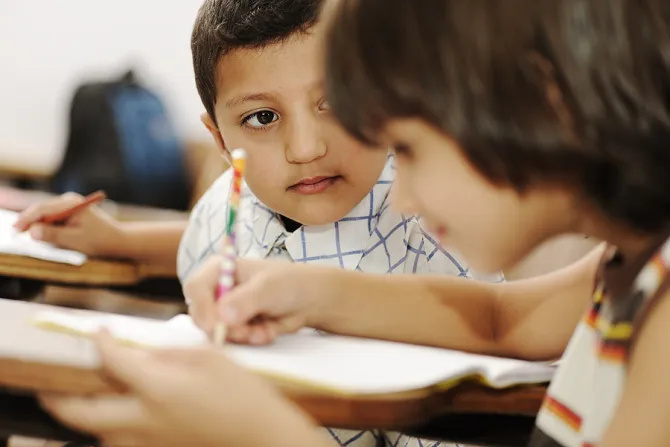Washington D.C., Mar 10, 2016 / 06:02 am
Hispanic Catholics are grossly underserved by Catholic schools in the United States, according to a new study, and this lack of participation could prove fatal to the future of the Church in the nation.
"Given the striking growth of the Hispanic Catholic school-age population and the declining enrollment in Catholic schools, the Church must be realistic and plan creatively - and prophetically - to serve this critical and growing group of American Catholics," stated Professor Hosffman Ospino of Boston College, a co-author of the report "Catholic Schools in an Increasingly Hispanic Church."
The report, published by Boston College and based on a nationwide survey of Catholic schools conducted in 2014, shows that Hispanic participation in Catholic schools has not only remained stagnant over two decades, but their enrollment is lower than even the number of non-Catholic students enrolled at Catholic schools.
"The numbers are without a doubt sobering," the report stated.
For instance, Hispanic Catholic school-age children, 8 million of them, make up 54 percent of the overall school-age Catholic population in the U.S., 14.8 million.
How many of them are in Catholic schools? Just 300,000, or four percent of the Hispanic Catholic school-age population and two percent of the overall Catholic school-age population.
And Catholic schools have not been able to adjust their staff to meet the needs of the growing Hispanic Catholic population.
Only 12 percent of teachers at Catholic schools who responded to the survey self-identified as Hispanic; only 14 percent of Catholic school principals self-identified as Hispanic and just 17 percent spoke fluent Spanish. About a quarter of those schools offered a second-language program for teachers.
Twenty-one percent of the schools offered signage in both English and Spanish. A little more offered prayers in both languages (35 percent) and conducted liturgies in both languages (36 percent).
This presents a major problem for the future of the Catholic Church in the U.S. because Hispanic Catholics – currently 40 percent of the Catholic population in the U.S. and 60 percent of the under-18 Catholic population – are not receiving catechesis offered in schools and in parish religious education programs.
Four percent attend Catholic schools, and only 10 percent of Hispanic children are enrolled in these religious education programs at parishes with Hispanic ministries.
"Catholicism in the United States, from its very beginnings, has been shaped by the experiences of millions of immigrants and their descendants," the report stated. "There is no doubt that Catholic schools continue to be a major referent for identity in the American Catholic experience."
Thus, "this is a unique opportunity for U.S. Catholics in the twenty-first century to reimagine the commitment to Catholic education in an increasingly Hispanic Church while building upon the best of our experiences and resources," the report continued.
While the numbers are "sobering," the reasons behind low Hispanic enrollment in Catholic schools aren't so clear-cut, the report declared.
For instance, Catholic schools have seen a decline in enrollment and the total number of schools in the last few decades, particularly since the year 2000, and this has hit urban areas especially hard. The number of religious – many of whom take vows of poverty – staffing these schools has fallen sharply, requiring the employment of lay staff and thus higher salaries. Some schools aren't able to stay open amid rising costs.
One initiative that might counter this trend is the "Two-Way Immersion Network," started in 2012 by Boston College. Member schools – currently 17 in number – aim to balance the student body between English- and Spanish-speakers. Bilingualism and biliteracy are emphasized, as well as an encounter of different cultures among the students.
(Story continues below)
Prayers at the schools are said in both English and Spanish, and the percentage of the Spanish speakers among teachers and staff members is also higher.
For instance, the report noted, St. Matthew School in Phoenix was not far from closing its doors in 2009 with an enrollment of only 159 students, most of whom were Hispanic. After it began implementing the Two-Way program, test scores went up and enrollment increased 25 percent. Students can now speak both English and Spanish.
There is a great need for programs like this, the report insisted, because most Hispanic children currently attend "hyper-segregated" public schools in urban areas, where the quality of the education is poor. This problem is compounded by Hispanic students having the highest dropout rate in the country.
Thus, these children are at a higher risk of poverty when they grow older. Already "about a third of all Hispanic children live in poverty," the report stated, probably the leading reason why Hispanic families may choose not to enroll their children in private schools.
The future of the Church in the U.S. may well be at stake if the needs of a populace that makes up 60 percent of its children are not met, the report asserted.
"It is imperative that we transform school environments so that the cultures that shape Church and society in our day joyfully meet and share genuine hospitality," the report concluded. "If Hispanic Catholic families perceive that they are welcomed with all they bring, they will likely look at Catholic schools as a strong option for the education of their children."



